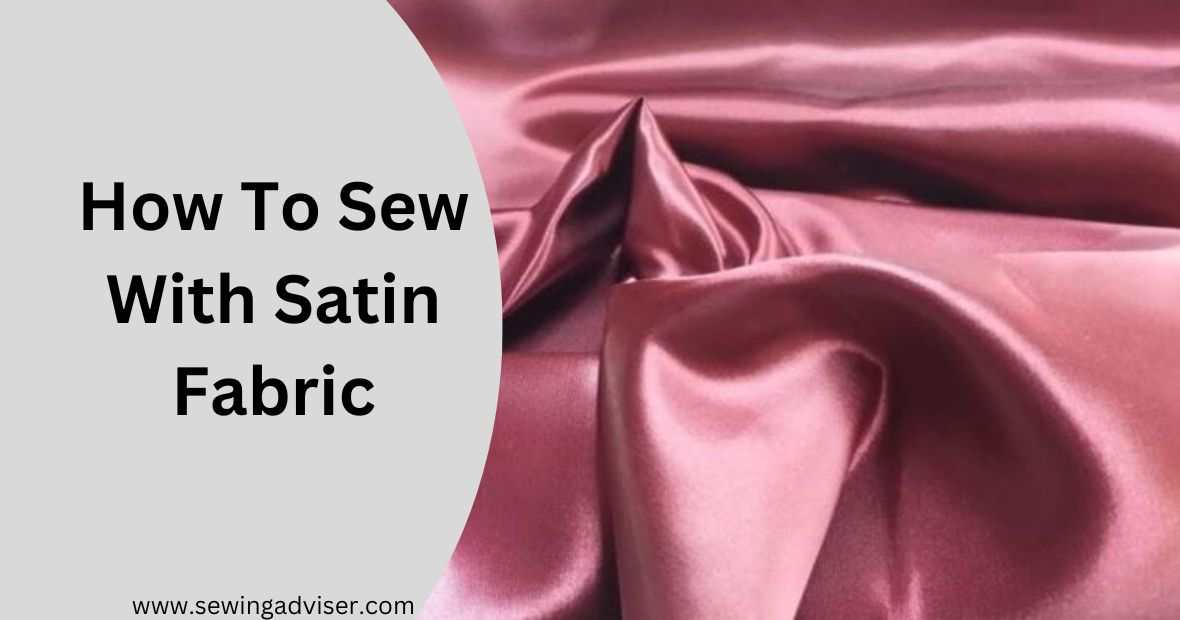How To Sew With Satin Fabric: 2024 Expert Tips & Techniques
Sewing with satin fabric can be a daunting task for even the most experienced of sewists. Satin’s delicate and slippery nature can make it challenging to cut, handle, and sew.
However, with a few tips and tricks, you can learn to work with satin fabric and create beautiful, luxurious garments and accessories.
In this guide, we will cover everything you need to know about how to sew with satin fabric, from choosing the right tools and materials to preparing your fabric, cutting and marking your pattern, and stitching your project together.
Whether you’re a seasoned pro or a beginner, this guide will help you achieve professional-looking results when sewing with satin.
What is Satin?
Satin is a type of fabric that is known for its glossy and smooth surface. It is typically made from silk, but can also be made from other materials such as polyester or nylon.
Satin is often used for clothing, especially formal attire such as dresses, skirts, and ties, as well as for bedding, upholstery, and other decorative purposes.
The distinctive sheen of satin is achieved through a weaving technique where the threads are woven in a way that creates a high number of floats on the surface of the fabric.
How to Sew with Satin Fabric: Step-By-Step Guide
By following these steps, you can sew with satin fabric confidently and create beautiful, luxurious garments and accessories.
Choosing the Right Needle and Thread
When sewing satin, it’s important to choose the right needle and thread. A sharp, fine needle is best for satin, as it will create smaller holes in the fabric and prevent snags and pulls.
A size 70/10 or 80/12 needle is ideal for satin. When it comes to thread, use a high-quality polyester or silk thread that matches the color of your fabric. Avoid using cotton thread, as it can be too rough for satin and may cause puckering or damage to the fabric.
Preparing Your Machine
Before you start sewing, make sure your machine is set up properly for satin. Here’s what you need to do:
- Change your needle to a size 70/10 or 80/12, as mentioned above.
- Use a straight stitch foot or a walking foot to help feed the fabric evenly through the machine.
- Adjust the tension on your machine. Satin requires a looser tension than other fabrics, so experiment with your machine to find the right tension setting.
- Use a new, sharp needle for each project, as a dull needle can damage your fabric.
Cutting and Marking Your Fabric
When cutting satin, use sharp scissors or a rotary cutter to prevent fraying. Be sure to cut the fabric on a flat surface, and avoid stretching the fabric while cutting. It’s also important to mark your fabric accurately, as satin can be easily damaged by pins and excessive handling.
Use tailor’s chalk or a water-soluble pen to mark your fabric, and make sure the markings are light and easy to remove.
Sewing Your Satin
Now that your machine is set up and your fabric is cut and marked, it’s time to start sewing. Follow these steps to sew satin on a sewing machine:
- Pin your fabric together using silk or fine pins, and make sure the pins are placed within the seam allowance to avoid leaving holes in the fabric.
- Start sewing with a backstitch to secure the seam, then stitch slowly and carefully, making sure the fabric is feeding evenly through the machine.
- Use a shorter stitch length than usual, such as 1.5mm or 2.0mm, to prevent puckering and ensure a smooth finish.
- If you’re having trouble with the fabric slipping, try using tissue paper or a layer of stabilizer underneath the fabric to help it feed smoothly through the machine.
- If you need to join two pieces of satin together, use a French seam or a flat-felled seam to create a strong, clean finish.
Finishing Your Seams
Once you’ve finished sewing your satin, it’s important to finish your seams to prevent fraying and ensure a professional-looking result. Here are some ways to finish your seams:
- Use pinking shears to trim the edges of your seams, then press them open and topstitch along the edges.
- Use a zigzag stitch or an overlock stitch to finish the raw edges of your seams.
- Apply a small amount of fray check to the edges of your seams to prevent fraying.
How to Hem Satin
Hemming satin can be tricky, but with the right technique, you can achieve a beautiful finish. Here’s how to hem satin:
- Fold the edge of your fabric up to the desired hem length and press it in place.
- Fold the raw edge of the hem under and press it in place.
- Pin the hem in place using silk or fine pins, and stitch it in place using a straight stitch or a blind hem stitch.
- If you’re having trouble with the fabric slipping, try using tissue paper or a layer of stabilizer underneath the fabric to help it feed smoothly through the machine.
Caring for Satin Fabric
Caring for satin fabric is essential to maintain its luster and longevity. Here are 3 tips to keep in mind:
- Hand wash or machine wash on a delicate cycle with cold water and a gentle detergent.
- Avoid using a dryer, instead, hang the fabric to air dry.
- Iron is on the wrong side with a low heat setting.
Best Tips and Tricks for Sewing Satin
Here are some additional tips and tricks for sewing satin on a sewing machine:
- Understand the nature of satin fabric: Satin is a smooth and shiny fabric that is delicate and slippery. Understanding its properties can help you handle it better.
- Choose the right needle and thread: Use a fine needle and polyester or silk thread that matches the color of the fabric.
- Use high-quality fabric scissors: Satin is prone to fraying, so it’s essential to have a sharp pair of scissors that can cut it cleanly.
- Practice with scraps before starting the project: Use scrap pieces of satin to practice your sewing techniques and make adjustments before starting your project.
- Use a walking foot: A walking foot can help feed the fabric evenly and prevent it from slipping while sewing.
- Adjust the tension: Satin fabric requires lower tension than other fabrics to prevent puckering or pulling.
- Avoid using pins: Pins can leave holes or snag the fabric, so it’s better to use clips or basting stitches instead.
- Use tissue paper for stability: Placing a layer of tissue paper between the fabric and the machine can help stabilize the fabric and prevent it from slipping.
- Press with caution: Satin can be easily damaged by heat, so use a low temperature and a pressing cloth to protect the fabric.
- Use a narrow hem: A narrow hem can create a clean finish without adding bulk to the fabric.
- Consider using French seams: French seams can encase the raw edges of the fabric, creating a neat and professional finish.
- Store satin fabric properly: Satin should be stored flat or rolled to prevent creasing or crushing.
Conclusion: How To Sew With Satin Fabric
I hope now that you are well aware of how to sew with satin fabric. In conclusion, Sewing with satin fabric requires some special techniques, but with the right tools and techniques, you can achieve professional-looking results.
Remember to prepare the fabric, choose the right needles and threads, and use the appropriate sewing techniques for your project. With these tips, you’ll be able to create beautiful garments and accessories with satin fabric.
FAQs: How To Sew With Satin Fabric
Can I Use a Serger to Sew Satin?
Yes, you can use a serger to sew satin. However, be sure to use a fine needle and high-quality thread to prevent damage to the fabric.
Can I Use a Regular Foot to Sew Satin?
It’s best to use a straight stitch foot or a walking foot when sewing satin, as this will help feed the fabric evenly through the machine.
What type of Thread is Best for Sewing Satin Fabric?
A lightweight thread that matches the fabric color is ideal for sewing satin. You can also use silk thread for a more luxurious finish.
How do I Prevent the Satin Fabric from Slipping while Sewing?
You can prevent the satin fabric from slipping by using tissue paper or a stabilizer underneath the fabric to hold it in place while sewing.
Is Satin Fabric Easy to Sew?
Satin fabric can be challenging to sew because it is slippery and prone to fraying, but with the right tools, techniques, and practice, you can sew satin successfully on a sewing machine.







16 Comments